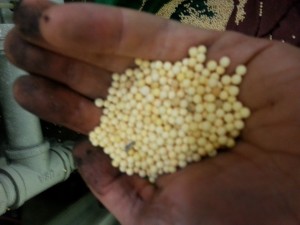Oil Contamination of a Desiccant Air Dryer
A customer recently called me saying his Van Air Systems model HL-250 desiccant air dryer had failed. The compressed air lines at his metal fabrication shop here in the Denver area were full of water. He’d installed the dryer 18 months earlier. The unit worked great. And then suddenly it didn’t.
Something had happened to the dryer, and now the water in his air lines was creating havoc with his production machinery.
I quickly scheduled a site visit. Before arriving at the shop I made a troubleshooting check list. Two classes of problems affect a desiccant dryer. There is either a mechanical fault, a process fault, or both.
Mechanical troubles involve the valves, seals, mufflers, and controls.
Process troubles involve the operating conditions, including air pressure, air temperature, ambient air temperature ranges, and lubricant contamination of the desiccant.
I arrived at the metal shop and a maintenance man showed me to the troubled air dryer. Along the way he grabbed a blow gun that was attached to air system and pulled the trigger. A long jet of water arced across the shop. “See how good your air dryer’s working,” he laughed.
I quickly got to work on the dryer, first running through the mechanical half of my check list. The dryer has our Cycle Saver dew point demand controller. I toggled a controller switch to operate the unit in fixed time mode, and I watched the unit cycle several times. The dryer moved through the drying and regeneration sequences perfectly, without triggering any alarms. This allowed me to rule out valve failure, plugged mufflers, bad solenoids, and a damaged control system. Next I checked the three PDV-500T zero loss pneumatic drain valves. One drain valve is installed on each the bulk moisture separator, coarse, and fine coalescing filters. Each PDV-500T drain has a test button. Press the button and pilot air activates the air cylinder that opens the drain’s ball valve. The valves were all working correctly. At this point it seemed unlikely that there’d been a mechanical failure on the air dryer or drains.
Next I looked at the process conditions. I started with compressed air temperature. High inlet compressed air temperature is a common problem, not just with desiccant dryers but any type of air dryer. The water vapor content of compressed increases exponentially with temperature. High temperatures overwhelm dryers. But high temperatures weren’t the culprit here. The air entering the dryer was only 102F. That’s slightly above the specification of the dryer, but not enough to cause condensation in plant air pipes.
Next I checked the air pressure. The dryer was running at about 105 PSIG. That’s right on spec. Low inlet pressure to a heatless desiccant dryer causes performance problems. But low pressure was not the culprit here.
Sometimes excessive inlet air flow is a source of trouble. But I ruled this out because the dryer was being fed by a single 50 horse power air compressor. A workable rule of thumb is the 1 HP of compression produces up to 4 – 4.5 SCFM of compressed air at 100 PSIG. It’s a rough guideline, but it works well enough for me to have determined that excessive air flow was not the cause of trouble. The HL-250 is designed for 250 SCFM @ 100 PSIG.
Next I ran my hand over each of the purge exhaust mufflers. My palm came away with a slick oily film. Bingo! I’d found a smoking gun.
I asked the maintenance man to take the compressor and dryer out of service; fortunately there is a back-up compressor. Next we opened a top coupling on each of the desiccant towers and peered inside to inspect the desiccant. The normally chalky white activated alumina beads within each tank were the color of weak coffee. Clearly the desiccant beds had been contaminated with compressor lubricant. Activated alumina is a porous adsorbent. It works by trapping water molecules within a lattice like surface. Hitting the alumina beads with oil is like covering a sponge in plastic wrap. Neither will hold water.
Here is a picture of some desiccant that I removed from one tower.

The yellow-brown tint is evidence of contamination by compressor lubricant. Clean activated alumina should be chalky white.
Shortly after my visit, the operator replaced the desiccant, along with the pre-filter elements and purge exhaust mufflers. This solved the problem and the production facility is once again enjoying liquid free compressed air.
One thing however remains somewhat of a mystery. I inspected each of the coalescing filter elements upstream of the dryer. All of the elements were intact, with no apparent ruptures. Remember too that each of the drains were working fine. There were no by-pass lines around the filters. So how did oil get into the dryer? I can only conclude that the compressor was leaking so much oil that the filters were simply overwhelmed. I’d never seen this happen. Have you? The head of the plant later told me that indeed the old compressor puts out a tremendous amount of oil, and he’s considering replacing the aging machine.
